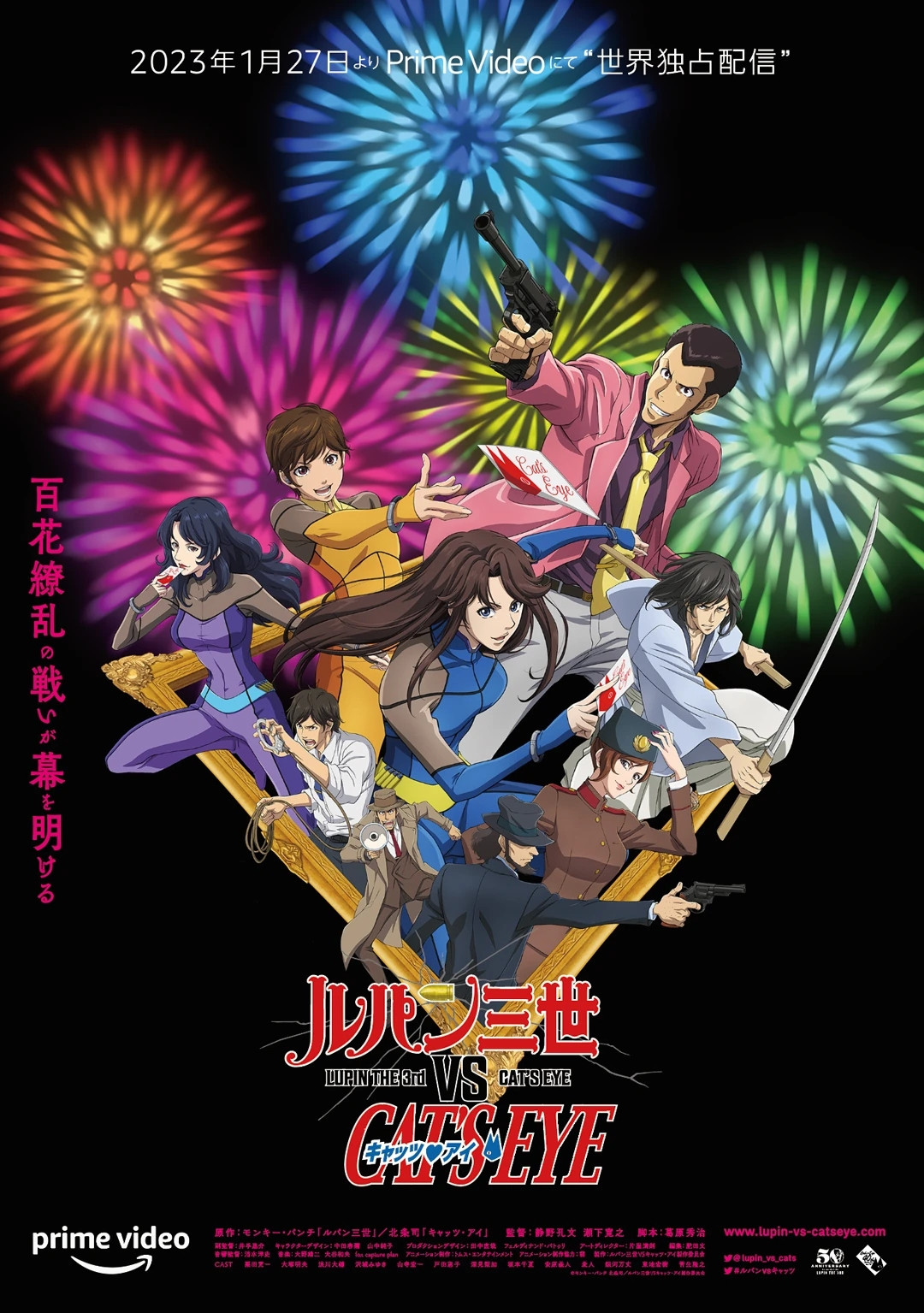For a dedicated Lupin fan, recent times have been a treasure trove. From Mystery of Mamo gracing YouTube to the origins story of Lupin Zero, the franchise has been consistently delivering content. So, when a crossover film featuring Cat’s Eye materialized, it was less of a surprise and more of an eagerly anticipated event. Writing about Lupin is always a pleasure, even if the entry isn’t a masterpiece, the sheer enjoyment factor of the franchise always shines through.
This film, a crossover with Cat’s Eye anime, was particularly intriguing. Familiarity with Cat’s Eye was limited to its premise: three captivating sisters who moonlight as art thieves targeting museums. Having a DVD of the first season, awareness of Cat’s Eye‘s existence predated this film’s arrival on Amazon Prime. Diving in without extensive prior knowledge felt like an exciting prospect, trusting that films often streamline narratives, leaving the deeper complexities for the series to explore later.
The Genesis of a Crossover Heist
 Lupin the 3rd vs Cat's Eye Poster
Lupin the 3rd vs Cat's Eye Poster
True to Lupin form, the film kicks off with a high-octane heist. Set on a Tokyo harbor, Lupin and his gang are in the midst of snatching a painting, naturally with Zenigata hot on their heels. Adding another layer of intrigue is Dennis, a ruthless hitman already pursuing the artwork Lupin is after, especially after Lupin’s impersonation at a prior deal. The opening is a whirlwind of classic Lupin chaos and action, setting a dynamic pace immediately.
Simultaneously, across town, the Cat’s Eye trio – the sisters Ai, Hitomi, and Rui, who by day run the quaint Cat’s Eye café – are executing their own museum heist. Their target is a different painting, one with personal significance, painted by their father. This heist is meticulously planned and fraught with intricate security measures, requiring all their skills and agility to overcome. This parallel heist serves as an excellent introduction to the Cat’s Eye sisters and their world, seamlessly weaving their narrative into the larger film’s plot. The opening sequences effectively establish both teams’ expertise and immediately captivate the viewer.
As a crossover, the narrative trajectory is fairly predictable. The two groups of thieves inevitably find themselves initially at odds. There’s even a deliberately misleading scene where Lupin displays an uncharacteristic aggression towards the sisters, suggesting a rivalry for the paintings. This initial tension cleverly misdirects the audience into anticipating a competitive dynamic. However, the real enjoyment lies in watching the Lupin gang and the Cat’s Eye sisters eventually unite against a common enemy. While the formula is familiar, the execution is undeniably satisfying, especially for fans of both franchises.
Lupin Gang Mentors the Cat’s Eye Sisters
A standout aspect of this film is the subtle mentorship role the Lupin gang assumes towards the Cat’s Eye sisters. Building on the character development seen since Lupin Part 5, this film portrays a more mature and less overtly mischievous Lupin. Even in his iconic pink jacket from Part 3, often associated with chaotic antics, Lupin embodies a sense of seasoned experience. While Rui, the eldest sister, is in her late twenties, the Cat’s Eye sisters are presented as relatively new to the scale of international heists that Lupin and his crew regularly navigate.
This dynamic leads to moments of genuine protectiveness from Lupin and his gang. Fujiko, ever the independent operator, plays her own game, initially aligning with the antagonists until her opportune moment arises. Meanwhile, Lupin, Jigen, and Goemon act as guardians, watching over the sisters. There are touching scenes, like Lupin sharing thieving tips with Ai while recovering from an injury, and Jigen and Goemon holding off threats to allow the sisters to complete their objectives. Despite his injuries, Lupin remains resourceful and full of tricks, while Jigen and Goemon are portrayed as steadfast and formidable as ever against formidable foes.
Crucially, the Cat’s Eye sisters are never depicted as helpless or childish. They are acknowledged as highly skilled thieves; their abilities are never in question. Their expertise is instrumental in overcoming the villains. The Lupin gang’s involvement is less about rescuing them and more about ensuring they aren’t left vulnerable to the dangerous world of powerful criminal organizations with vast resources. This protective stance is genuinely heartwarming and adds a layer of depth to the crossover narrative.
Modern Lupin Tropes and Nuances
 Lupin and Cat's Eye Team Up
Lupin and Cat's Eye Team Up
As a dedicated, though perhaps not veteran, Lupin enthusiast, certain trends in modern Lupin adaptations are becoming noticeable. A recurring theme is the addition of backstories for Lupin, often where they feel unnecessary. This film is no exception, attempting to forge a connection between Lupin and the Cat’s Eye sisters through a shared past. While this adds a layer of narrative, it can feel somewhat forced for a franchise traditionally built on episodic adventures.
Another shift is towards a more family-friendly portrayal of Lupin. He is depicted as more mature, less overtly womanizing, and burdened by the sins of his past, tied to the film’s backstory. This contrasts with the classic, more episodic Lupin, where each caper was largely self-contained. While this mature take on Lupin echoes elements of Castle of Cagliostro, it also raises the question of whether Lupin’s inherent charm lies in his roguish nature, rather than a newly imposed need for a complex past.
The choice of antagonists also warrants a mention. The villains are revealed to be Neo-Nazis. While thematically relevant to European art and historical context, and undeniably satisfying to see Lupin thwart such abhorrent figures, it can feel like a somewhat predictable and less nuanced choice for antagonists. However, there’s no denying the cathartic pleasure of watching Lupin dismantle Neo-Nazis – some villains are simply too deserving of comeuppance to overthink.
Final Verdict
The entire film is rendered in CG animation, and while CG anime can be hit or miss, Lupin the 3rd vs. Cat’s Eye lands firmly on the positive side. It doesn’t reach the breathtaking heights of Lupin III: The First, where the CG was remarkably fluid and expressive, but it surpasses average CG anime quality, perhaps aligning with the level of Knights of Sidonia. The character designs for both Lupin and Cat’s Eye have been subtly adapted to create visual consistency within the shared universe. While some moments of CG animation feel slightly stiff, the overall visual presentation is commendable, especially considering the complexity of a crossover film of this scale. The effort invested in both scripting and animation is evident, making minor animation quirks forgivable.
In conclusion, Lupin the 3rd vs. Cat’s Eye is a thoroughly enjoyable crossover. In its hour and a half runtime, it delivers engaging character interactions, stylish action sequences, and a Lupin adventure that feels both familiar and fresh. It also offers a deeper glimpse into the personalities of the Cat’s Eye sisters. Even with a somewhat predictable plot trajectory, the film maintains a brisk pace and culminates in a satisfying resolution. While reactions from long-time Lupin fans might be varied, this film offers a fun and accessible entry point into both franchises and is likely to resonate with a broad audience. If you’re a fan of heist stories, stylish animation, or either Lupin or Cat’s Eye anime, this crossover is definitely worth watching.
